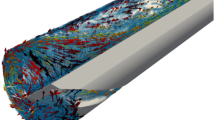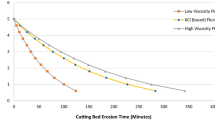Abstract
One of the main targets of hole cleaning is increasing drilling efficiency. Insufficient hole cleaning causes several problems. In this paper, the effects of stabilizer application on hole cleaning have been investigated. Some experimental tests were performed by a closed flow loop to analyze the effect of the presence of a drilling stabilizer at different positions in the Bottom Hole Assembly (BHA) and different hole inclinations. To achieve this goal, a stabilizer with four straight blades was designed and conducted in various experiments and simulations. Some experiments were performed by installing the stabilizer in two different positions of BHA “Near Bit” (NB) and “Far From Bit” (FFB) in different hole inclinations. Finally, a prediction model in FLUENT software is proposed to study the behavior of cuttings along the annulus in the presence of a stabilizer for the conditions that cannot be investigated by the experimental setup. According to the comparison between the experimental and simulation data, the presence of a drilling stabilizer has a significant effect on improving the cutting transport and subsequently hole cleaning rate. The results show that stabilizer application assists the hole cleaning at all inclinations except 0° (vertical well). At vertical annuluses, the rotational movement of the stabilizer decreases the cuttings lift force. Moreover, the FFB condition increases the rate of hole cleaning considerably more than NB. Thus, stabilizers by raising the fluid flow turbulency increase the capability of removing the cuttings from the system in most annulus inclinations.




















Similar content being viewed by others
Abbreviations
- BHA:
-
Bottom hole assembly
- CFD:
-
Computational fluid dynamics
- FFB:
-
Far from bit
- F d :
-
Drag force
- F g :
-
Weight force
- F b :
-
Buoyancy force
- F l :
-
Lift force
- F f :
-
Friction force
- F ga :
-
Weight force component opposite of flow direction
- F gva :
-
Weight force component perpendicular to flow direction
- LPLT:
-
Low pressure low temperature
- NB:
-
Near bit
- PDC:
-
Polycrystalline diamond compacts
- WOB:
-
Weight on bit
- WOS:
-
Without stabilizer condition
- STB:
-
With stabilizer condition
References
RS Carden R. D. 2007 Horizontal and Directional Drilling Petroskills, LLC. AN OGCI Company Tulsa, Oklahoma
Smith. 1982 Drillind Assembly Handbook DrilCo Houston, Texas
X Sun Y Tie L Wei W Yanze 2013 Study on cuttings transport efficiency affected by stabilizer’s blade shape in vertical wells Open Petrol. Eng. J. https://doi.org/10.2174/1874834101306010007
Dehvedar, M., & Moarefvand, P. (2019). Detecting and drilling in critical inclination window in slant wells by means of a two phase liquid-solid CFD model and experimental study. Kuwait Journal of Science, 46(2).
L Yeo Y Feng A Seibi A Temani N Liu 2021 Optimization of hole cleaning in horizontal and inclined wellbores: a study with computational fluid dynamics J. Petrol. Sci. Eng. 205 108993 https://doi.org/10.1016/j.petrol.2021.108993
Azar, J. J., & Sanchez, R. A. (1997). Important issues in cuttings transport for drilling directional wells. In: Latin American and Caribbean Petroleum Engineering Conference. Society of Petroleum Engineers. https://doi.org/10.2118/39020-MS
M Duan SZ Miska M Yu NE Takach RM Ahmed CM Zettner 2009 Critical conditions for effective sand-sized solids transport in horizontal and high-angle wells SPE Drill. Complet. 24 02 229 238 https://doi.org/10.2118/106707-PA
Bilgesu, H. I., Mishra, N., & Ameri, S. (2007). Understanding the effect of drilling parameters on hole cleaning in horizontal and deviated wellbores using computational fluid dynamics. In: Eastern Regional Meeting. Society of Petroleum Engineers. https://doi.org/10.2118/111208-MS
MS Khaled MS Khan H Ferroudji A Barooah MA Rahman I Hassan AR Hasan 2021 Dimensionless data-driven model for optimizing hole cleaning efficiency in daily drilling operations J. Natural Gas Sci. Eng. 96 104315 https://doi.org/10.1016/j.jngse.2021.104315
S Akhshik M Behzad M Rajabi 2015 CFD–DEM approach to investigate the effect of drill pipe rotation on cuttings transport behavior J. Petrol. Sci. Eng. 127 229 244 https://doi.org/10.1016/j.petrol.2015.01.017
E GhasemiKafrudi SH Hashemabadi 2016 Numerical study on cuttings transport in vertical wells with eccentric drillpipe J. Petrol. Sci. Eng. 140 85 96 https://doi.org/10.1016/j.petrol.2015.12.026
Pastusek, P. E. (2018). Stabilizer Selection Based on Physics and Lessons Learned. In: IADC/SPE Drilling Conference and Exhibition. Society of Petroleum Engineers. https://doi.org/10.2118/189649-MS
Egenti, N. B. (2014). Understanding drill-cuttings transportation in deviated and horizontal wells. In: SPE Nigeria annual international conference and exhibition. Society of Petroleum Engineers. https://doi.org/10.2118/172835-MS
Wiley, C. (1965). The Use of Near-bit Stabilizer-sub Assemblies for the Control of Hole Deviation. In Drilling and Production Practice. American Petroleum Institute.
O'Bryan, P. L., & Huston, C. W. (1990). A study of the effects of bit gauge length and stabilizer placement on the build and drop tendencies of PDC bits. In: SPE Annual Technical Conference and Exhibition. Society of Petroleum Engineers. https://doi.org/10.2118/20411-MS
Radford, S. R., Jenkins, M. A., & Li, T. (2009). Novel concentric expandable stabilizer results in increased penetration rates and drilling efficiency with reduced vibration. In: SPE/IADC drilling conference and exhibition. Society of Petroleum Engineers. https://doi.org/10.2118/119534-MS
McCormick, J. E., Osorio, G., Andachi, J. H., & Barth, M. E. (2011). Adjustable gauge stabilizer and torque reduction tools reduce overall drilling times by 20%: a case study. In: SPE Middle East Oil and Gas Show and Conference. Society of Petroleum Engineers. https://doi.org/10.2118/141673-MS
J TaheriShakib H Jalalifar M Fatehirad 2012 Design of continuous gauge near-bit stabilizer, using optimized hydraulics and gauge geometry in Mishan andAghajari formation J. Chem. Petrol. Eng. 46 1 31 39
Uddin, H., Choudhury, N. R., & Ansari, U. (2016). A Computational Study of Packoff Using a Combined Drill Bit Stabilizer Particle Tracking Simulation. In: SPE Western Regional Meeting. Society of Petroleum Engineers. https://doi.org/10.2118/180380-MS
M Dehvedar P Moarefvand AR Kiyani 2019 A liquid-solid two-phase flow computational fluid dynamic modelling of the operational characteristics effects on the cleaning time of a circulating flow loop South African J. Chem. 72 67 79
SM Han NS Woo YJ Kim 2016 A study of the particle transport in the non-newtonian fluid with inclined annulus Asia-Pacific J. Model. Simulation for Mech. Syst. Design Anal. 1 1 23 28 https://doi.org/10.21742/ajmsm.2016.1.1.04
JL Vieira Neto AL Martins CH Ataide MA Barrozo 2012 Non-Newtonian flows in annuli with variable eccentric motion of the inner tube Chem. Eng. Technol. 35 11 1981 1988 https://doi.org/10.1002/ceat.201200239
M Kamyab V Rasouli 2016 Experimental and numerical simulation of cuttings transportation in coiled tubing drilling J. Natural Gas Sci. Eng. 29 284 302 https://doi.org/10.1016/j.jngse.2015.11.022
M Dehvedar P Moarefvand AR Kiyani AR Mansouri 2019 Using an experimental drilling simulator to study operational parameters in drilled-cutting transport efficiency J. Mining and Environ. 10 2 417 428 https://doi.org/10.22044/jme.2019.7665.1624
JT Cornelissen F Taghipour R Escudié N Ellis JR Grace 2007 CFD modelling of a liquid–solid fluidized bed Chem. Eng. Sci. 62 22 6334 6348 https://doi.org/10.1016/j.ces.2007.07.014
X Huang 2011 CFD modeling of liquid–solid fluidization: effect of drag correlation and added mass force Particuology 9 4 441 445 https://doi.org/10.1016/j.partic.2011.03.005
J Riera S Zeppieri S Derjani-Bayeh 2014 Hydrodynamic study of a multiphase spouted column Fuel 138 183 192 https://doi.org/10.1016/j.fuel.2014.08.007
A Tripathy S Bagchi SK Biswal BC Meikap 2017 Study of particle hydrodynamics and misplacement in liquid–solid fluidized bed separator Chem. Eng. Res. Des. 117 520 532 https://doi.org/10.1016/j.cherd.2016.11.009
K Zhang G Wu S Brandani H Chen Y Yang 2012 CFD simulation of dynamic characteristics in liquid–solid fluidized beds Powder Technol. 227 104 110 https://doi.org/10.1016/j.powtec.2012.01.030
Author information
Authors and Affiliations
Corresponding author
Rights and permissions
Springer Nature or its licensor (e.g. a society or other partner) holds exclusive rights to this article under a publishing agreement with the author(s) or other rightsholder(s); author self-archiving of the accepted manuscript version of this article is solely governed by the terms of such publishing agreement and applicable law.
About this article
Cite this article
Mansoury, A., Kiani, A., Dehvedar, M. et al. Well Annulus Cleaning While Using Stabilizer with an Experimental Flow Loop and its CFD Model. Arab J Sci Eng 48, 9413–9427 (2023). https://doi.org/10.1007/s13369-022-07526-6
Received:
Accepted:
Published:
Issue Date:
DOI: https://doi.org/10.1007/s13369-022-07526-6




